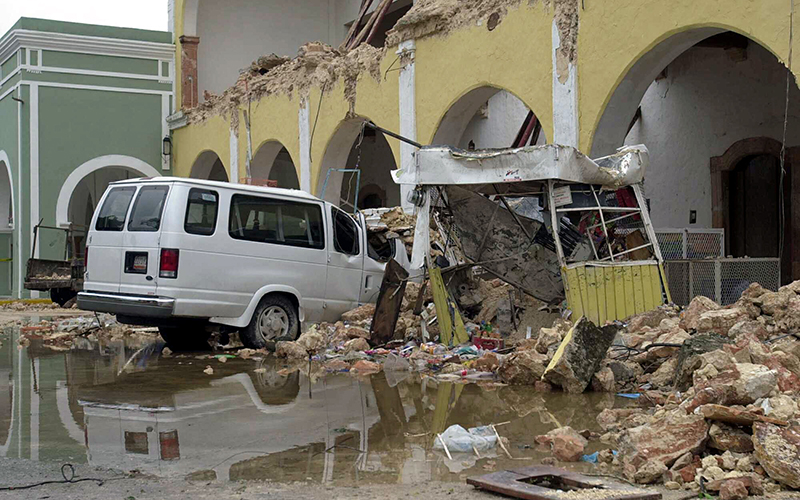
As residents experience the onset of the heat of summer, it’s a reminder that it’s time to prepare for Hurricane Season in Yucatán — and the rest of the Atlantic — from June 1 to Nov. 30.
While the Yucatán isn’t in the most hurricane-prone zone of the Caribbean, preparation saves lives. The importance of this message has been underscored by recent history and predictions of heightened storm activity this year.
A Look Back: When Storms Wreaked Havoc
Though statistically less likely to be struck by major hurricanes than other coastal regions, the Yucatán has not been immune. Hurricane Wilma in 2005 remains a stark reminder of nature’s fury. Wilma stalled over the region for days, causing significant flooding and damage. More recently, though less devastating, numerous tropical storms have made landfall, disrupting coastal communities.
“Hurricanes are a part of life in this region,” said Dr. Enrique Flores, a meteorologist at the National Weather Center in Mérida. “Though the Yucatán often escapes the worst of it, the risk is always present, and preparedness is essential.”
Predictions for 2024: Increased Activity Expected
While long-term hurricane forecasting is not an exact science, experts suggest that the 2024 hurricane season in Yucatán may be more active than average. This prediction is based on various factors, including warmer-than-usual ocean temperatures and favorable atmospheric conditions.
“We anticipate a higher number of named storms this year and a greater potential for some of them to reach hurricane strength,” Flores added. “It’s not a cause for panic, but it certainly underscores the need to take this seriously.”
Preparation: Your First Line of Defense
In preparation for hurricane season in Yucatán, the U.S. Consulate offers guidance to American citizens, emphasizing the importance of preparedness but acknowledging their limited ability to provide direct aid during emergencies.
Recommended steps include ensuring passports are current, registering with the Smart Traveler Enrollment Program (STEP) for updates, and securely storing copies of essential documents.
While sturdy homes may withstand hurricanes, power and water outages are common. A 72-hour emergency kit with food, water, and supplies is crucial. This kit should include essentials like a first-aid kit, flashlight, batteries, whistle, dust mask, and hygiene items. Additional supplies, such as medications, pet food, and cash, are also recommended.
Evacuation orders from local authorities must be followed. In Yucatán, while individuals can choose not to evacuate, it’s discouraged. In Quintana Roo, evacuation may be enforced under extreme circumstances, even for U.S. citizens.
“We’re a resilient people,” said Fabiola Gutiérrez, the former mayor of Cancún, a city particularly mindful of hurricane risks. “Preparation and community spirit are how we mitigate potential losses and protect lives.”
In addition to physical preparations, financial preparedness is crucial. Hurricane damage can be costly. Having adequate insurance on your home or business offers peace of mind.
Basic Disaster Supplies Kit
Store items in airtight plastic bags and put your entire disaster supplies kit in one or two easy-to-carry containers such as plastic bins. The kit should include:
- Water (one gallon per person per day for at least three days, for drinking and sanitation)
- Food (at least a three-day supply of non-perishable food)
- Battery-powered or hand crank radio and a NOAA Weather Radio with tone alert
- Flashlight
- First aid kit
- Extra batteries
- Whistle (to signal for help)
- Dust mask (to help filter contaminated air)
- Plastic sheeting and duct tape (to shelter in place)
- Moist towelettes, garbage bags and plastic ties (for personal sanitation)
- Wrench or pliers (to turn off utilities)
- Manual can opener (for food)
- Local maps
- Cell phone with chargers and a backup battery
Additional Emergency Supplies
The Center for Disease Control recently recommended additional items:
- Cloth face coverings (for everyone ages 2 and above), soap, hand sanitizer, disinfecting wipes to disinfect surfaces
- Prescription medications
- Non-prescription medications such as pain relievers, anti-diarrhea medication, antacids or laxatives
- Prescription eyeglasses and contact lens solution
- Infant formula, bottles, diapers, wipes and diaper rash cream
- Pet food and extra water for your pet
- Cash or traveler’s checks
- Important family documents, such as copies of insurance policies, identification and bank account records, saved electronically or in a waterproof, portable container
- Sleeping bag or warm blanket for each person
- Complete change of clothing appropriate for your climate and sturdy shoes
- Fire extinguisher
- Matches in a waterproof container
- Feminine supplies and personal hygiene items
- Mess kits, paper cups, plates, paper towels and plastic utensils
- Paper and pencil
- Books, games, puzzles or other activities for children
If you are forced to leave your home, going to a shelter is a last resort. In Mérida, a city agency keeps up-to-date shelter locations here.
If you do go to a shelter, pack lightly and take a thick blanket, a change of clothes, including extra shoes. Although the shelter will provide some, take your own extra food and water. Also, take your most important papers, such as your passport and birth certificate, in a plastic bag. Don’t forget your emergency cash, medicines, and personal hygiene items. Only one suitcase per person is allowed.
Mexico’s Warning System
The national Mexican warning system is called the “Early Warning System for Tropical Cyclones” (SIAT – CT). Alerts will be transmitted in English and Spanish during a crisis.
Blue Alert: Watch — The presence of a tropical cyclone has been detected or more than 72 hours remain before the cyclone’s 34-knot (63-km/h) wind line reaches an affected area. The danger is considered to be minimal. At this stage, bulletins will be issued every 24 hours.
Green Alert: Prevention — Between 24 and 72 hours remain before the cyclone’s 34-knot (63-km/h) wind line reaches an affected area, depending on the intensity of the cyclone. The danger is considered to be low. At this stage, bulletins will be issued every 12 hours. Stay informed on tropical cyclones and the measures to be taken.
Yellow Alert: Preparation — This is when between 12 and 60 hours remain before the cyclone’s 34-knot (63-km/h) wind line reaches an affected area, depending on the intensity of the cyclone. The danger is considered to be moderate. At this stage, bulletins will be issued every six hours. The community is expected to pay close attention to official information, learn the location of temporary shelters, prepare for a possible evacuation and take self-protection measures.
Orange Alert: Alarm — This means between six and 36 hours remain before the cyclone’s 34-knot (63-km/h) wind line reaches an affected area or impact is imminent. The danger is considered to be high. At this stage, bulletins will be issued every three hours. The community is expected to evacuate at-risk areas, follow instructions from the authorities and cancel any boating or coastal activities.
Red Alert: Effects Present — A tropical cyclone is impacting an area. The danger is considered to be maximum. At this stage, bulletins will be issued every three hours. The community is expected to seek immediate shelter and obey authorities.
Stay informed
Here’s where to find news during a storm:
- The US National Hurricane Center
- The US Embassy Mexico City Travel Alert Website
- The US Embassy Mexico City Facebook Page
- The Mexican National Hurricane Center
Cancún
· City Hall Radio (Radio Ayuntamiento): FM 105.9 (Spanish)
Playa Del Carmen
Chetumal
· Civil Protection of Quintana Roo (Click “Alertas” on the left for specific storm advisories) (Spanish)
Mérida
· Mérida’s Department of Civil Protection (Spanish)—Includes list of all local emergency telephone numbers, including hospitals. Also call 999-944-3532, 999-944-2470 or 800-719-8633.
· Local SIPSE TV and Radio
What if you want to stay?
In Yucatán, if someone chooses not to evacuate during an emergency, even after the Mexican Military and Navy attempt to enforce the evacuation, Civil Protection will respect the person’s decision.
But in Quintana Roo, Civil Protection states that in extreme life-and-death circumstances, authorities may evacuate people, including U.S. citizens, against their will. Fantasies of the consulate airlifting residents out of their homes are just scenes from a movie.







